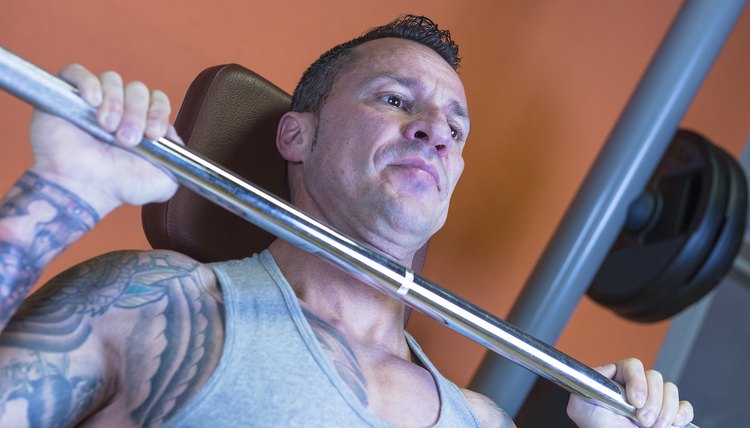What Muscles Do Barbell Military Presses Work?

The barbell military press is a strict overhead press that uses no leg drive, backward lean or any other body English to make the exercise easier. It is best performed with the bar set in a shoulder-height squat rack so it is easy to get into the correct starting position. To maximize your performance, keep your abs tight, forearms vertical, chest up and exhale as you drive the bar overhead.
Agonists
The agonists, or primary muscles, used in the barbell military press are the deltoids, or shoulder muscles. You have three deltoid muscles: anterior, medial and posterior, located on the front, side and back of your shoulder, respectively. The military press uses all three deltoids, but the anterior works the hardest. Bodybuilders and athletes perform military presses because they are effective in developing increased deltoid size and strength.
Synergists
Synergists are helper muscles that, although very active in the performance of an exercise, are secondary to the agonist. There are a variety of synergists in barbell military presses but the most notable are the triceps and upper trapezius muscles. The initial upward drive of the barbell is initiated by the deltoids, but pushing the bar fully overhead is the job of the triceps, which are located on the rear of your upper arm. The upper trapezius, located across your upper back and just below the base of your skull, works hard to pull your shoulder upward as you complete the lift and lock out the bar overhead.
Fixators
Fixators are stabilizing muscles that hold your joints in position so the agonists and synergists can work as efficiently as possible. As barbell military presses are performed in a standing position, just about every muscle in your body must work hard to keep you upright. However, there are a couple of notable fixators that are more active than others, including the core, or the muscles of your midsection. These muscles must work hard to keep your spine, specifically your lower back, locked in position. A weak core can severely limit the amount of weight you lift overhead. In addition, your rotator cuff, which consists of four small muscles deep within your shoulder joint, must work to keep the head of your humerus securely located in the socket of your shoulder.
Antagonists
Muscles are arranged in pairs across joints. When one muscle contracts, the opposing muscle, which is called the antagonist, must relax to allow uninhibited movement. The antagonist to the deltoids is the latissimus dorsi muscle, which is located on the lateral aspect of your back, directly below your armpit. This muscle relaxes as you press the barbell up and overhead. Overly tight lats can make fully extending your arms more difficult than it should be.
References
- "Anatomy of Exercise: A Trainer's Inside Guide to Your Workout"; Pat Manocchia; 2009
- "Starting Strength (2nd Edition); Mark Rippetoe, et al.; 2007
- "5/3/1: The Simplest and Most Effective Training System to Increase Raw Strength"; Jim Wendler; 2009
- Uribe BP, Coburn JW, Brown LE, Judelson DA, Khamoui AV, Nguyen D. Muscle activation when performing the chest press and shoulder press on a stable bench vs. a Swiss ball. J Strength Cond Res. 2010;24(4):1028–1033. doi:10.1519/JSC.0b013e3181ca4fb8
- Bryant, C. X., & Green, D. J. (2011). ACE's essentials of exercise science for fitness professionals. San Diego, CA: American Council on Exercise.
- Ludwig O, Kelm J, Hammes A, Schmitt E, Fröhlich M. Targeted Athletic Training Improves the Neuromuscular Performance in Terms of Body Posture From Adolescence to Adulthood - Long-Term Study Over 6 Years. Front Physiol. 2018;9:1620.
- Cramer H, Mehling WE, Saha FJ, Dobos G, Lauche R. Postural awareness and its relation to pain: validation of an innovative instrument measuring awareness of body posture in patients with chronic pain. BMC Musculoskelet Disord. 2018;19(1):109.
- Saeterbakken AH, Fimland MS. Effects of body position and loading modality on muscle activity and strength in shoulder presses. J Strength Cond Res. 2013;27(7):1824–1831. doi:10.1519/JSC.0b013e318276b873
- Park HK, Jung MK, Park E, et al. The effect of warm-ups with stretching on the isokinetic moments of collegiate men. J Exerc Rehabil. 2018;14(1):78–82. Published 2018 Feb 26. doi:10.12965/jer.1835210.605
Resources
Writer Bio
Patrick Dale is an experienced writer who has written for a plethora of international publications. A lecturer and trainer of trainers, he is a contributor to "Ultra-FIT" magazine and has been involved in fitness for more than 22 years. He authored the books "Military Fitness", "Live Long, Live Strong" and "No Gym? No Problem!" and served in the Royal Marines for five years.
